MARIANI’SVirtual
Gourmet
January 12,
2014
NEWSLETTER
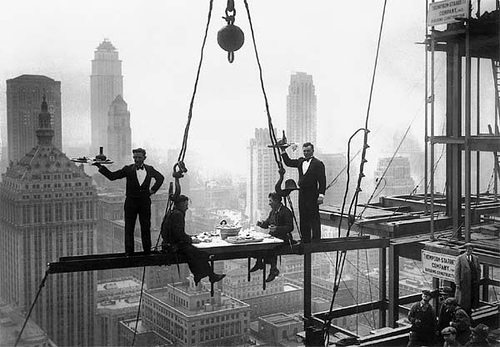
Publicity Stunt
Dinner on the Empire State Building Scaffolding
(1932)
THIS WEEK
NEW
RESTAURANTS IN ATLANTA
By John Mariani
NEW
YORK CORNER
MINTON'S AND CECIL
By John Mariani and Robert Mariani
NOTES
FROM THE WINE CELLAR
PRESTIGE CUVÉE CHAMPAGNES
By Brian A. Freedman
❖❖❖
NEW
RESTAURANTS IN ATLANTA
By John Mariani

Atlanta’s reputation as being the South’s best restaurant city is increasingly challenged by smaller ones like Charleston and Nashville. But Atlanta still holds sway by virtue of the diversity of restaurants in every section of town, from Downtown to Buckhead, and by the ethnic offerings that are easily the most varied of any city south of Chicago. Of course, New Orleans has a far more highly developed indigenous gastronomy, but it cannot match the overall breadth and depth of Atlanta’s offerings. And, each time I visit, I’m delighted to see how the city’s restaurant sector expands, sometimes by copying concepts from elsewhere, but largely based on a deep field of innovative chefs for whom Atlanta has long been home.
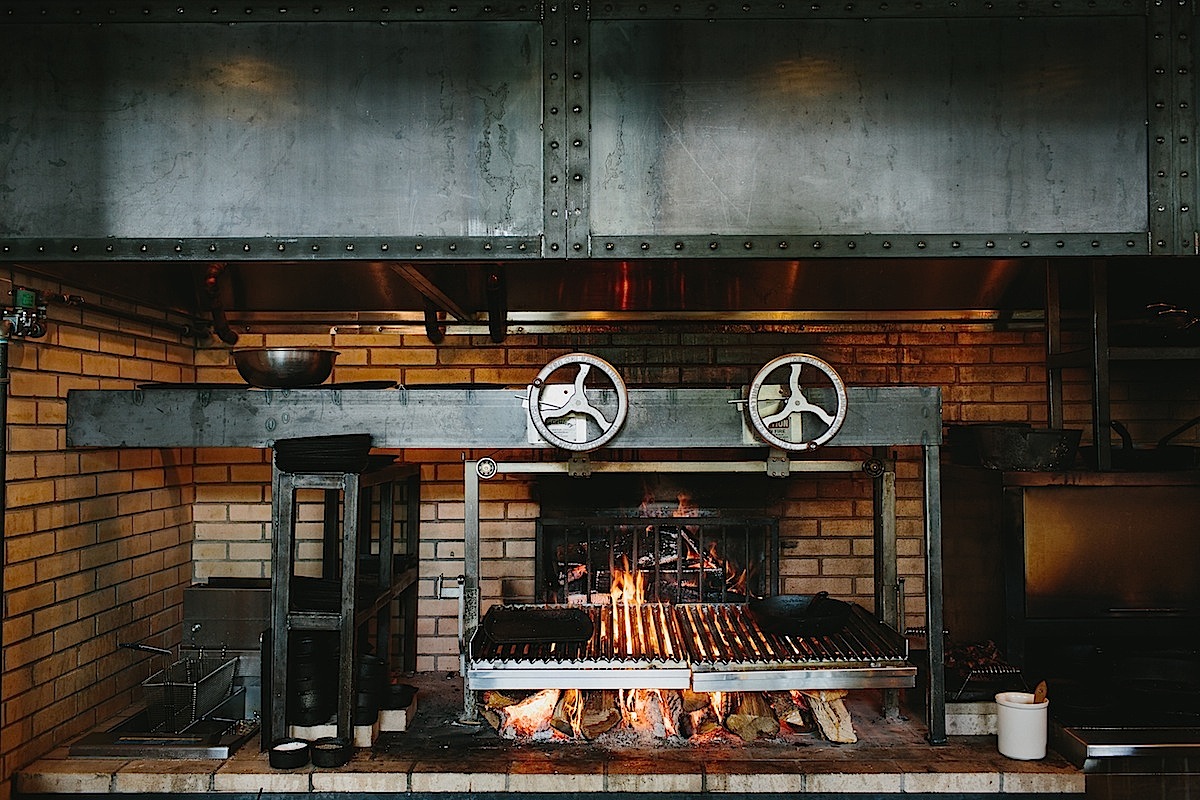 KING + DUKE
KING + DUKE
3600 Peachtree Road NW
404-477-3500
http://kinganddukeatl.com
Chef
Ford Fry’s The Optimist was my choice in Esquire as
Best New Restaurant of 2012, and, while his
brand new place, King + Duke, didn't quite tag that
highest honor in 2013, it’s not a place you’d
want to miss if you’re going to Atlanta. Where
The Optimist is all about great seafood, King + Duke
(named after two grifters in The Adventures of
Huckleberry Finn) is centered around wood-fire
cooking from a 24-foot hearth in an open kitchen (left). Chef de
Cuisine Joseph Schafer seeks in every dish to
“accentuate natural flavors through slower methods of
cooking and the smoke of the wood fire.” Which
will have you salivating when you get a platter of
roasted bone marrow with smoked mushrooms salad, 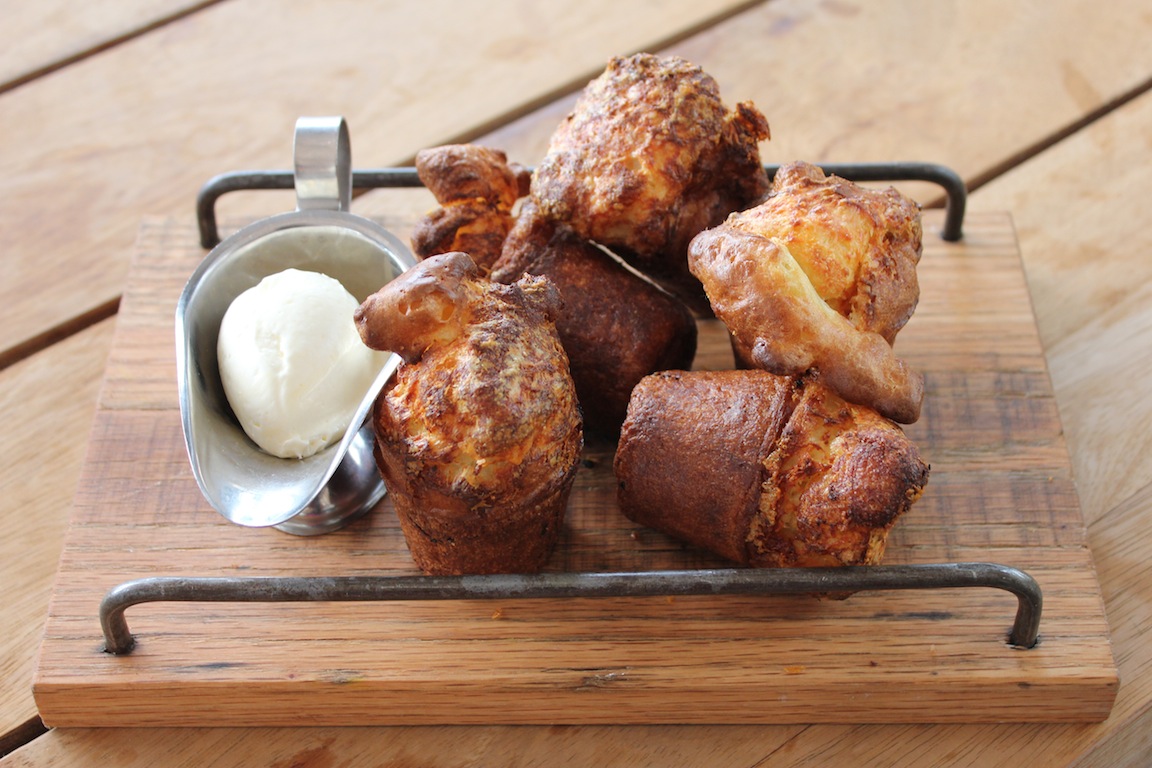 or the candied
lamb belly with sheep’s milk feta. Mississippi rabbit
comes with a farro grain salad and rabbit liver on
toast, and Maine lobster wood roast takes on smoky
levels of flavor, along with bok choy, garlic and a
chile kick. And
you get popovers, too, hot and steamy from the
hearth (right).
Even desserts, by Chrysta Poulos, take advantage of
that hearth in sweets like dulcey panna cotta with
grilled peaches.
or the candied
lamb belly with sheep’s milk feta. Mississippi rabbit
comes with a farro grain salad and rabbit liver on
toast, and Maine lobster wood roast takes on smoky
levels of flavor, along with bok choy, garlic and a
chile kick. And
you get popovers, too, hot and steamy from the
hearth (right).
Even desserts, by Chrysta Poulos, take advantage of
that hearth in sweets like dulcey panna cotta with
grilled peaches.
King + Duke is resolutely American,
right down to beers on a 200-label list currently
being made in the 13 original colonies, along with a
slew of American ales. If you want to find Atlantans
of every stripe having a grand old time, check out
King + Duke any night of the week from five o’clock
till midnight.
Lunch Mon.-Fri.;
dinner nightly; appetizers $6-$16, main courses
$16-$49.
UMI
3050 Peachtree Rd NE
404-841-0040
umiatlanta.com
photos by Sara Hanna
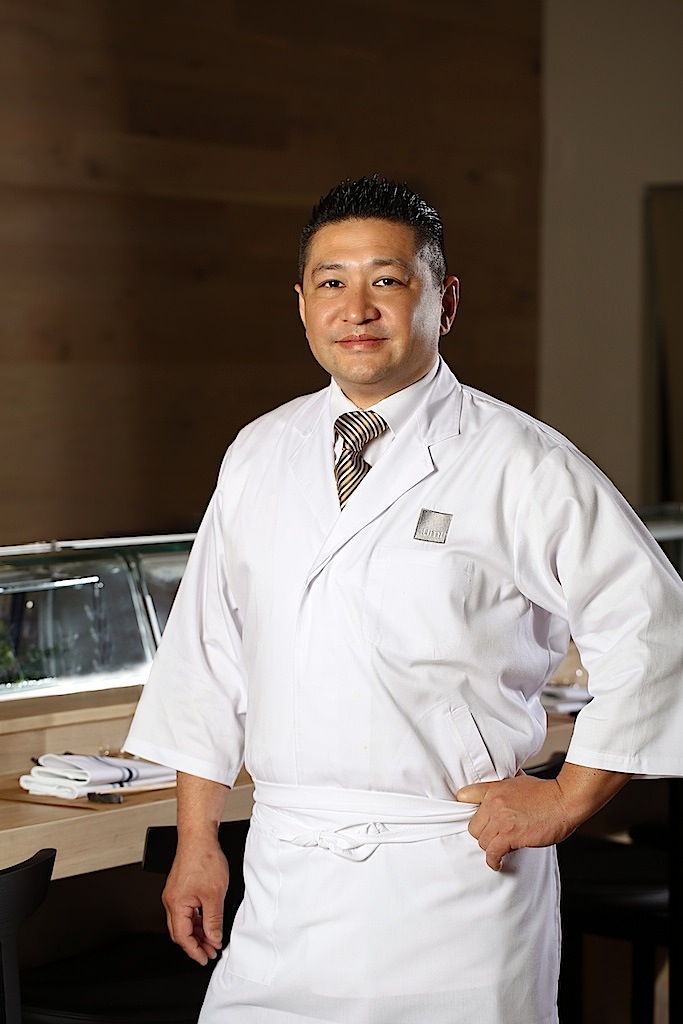 One
of the most highly regarded Japanese restaurants in
Atlanta some years ago was the brash MF Sushi, where
Tokyo-born Chef Fuyuhiko Ito (left) dazzled guests who learned not
to expect the ordinary and always to anticipate
surprise. Sadly, after an expansion, MF’s
publicity-loving owner took his eye off the ball,
closing down and relocating to Houston (where a recent
fire has shuttered the restaurant).
One
of the most highly regarded Japanese restaurants in
Atlanta some years ago was the brash MF Sushi, where
Tokyo-born Chef Fuyuhiko Ito (left) dazzled guests who learned not
to expect the ordinary and always to anticipate
surprise. Sadly, after an expansion, MF’s
publicity-loving owner took his eye off the ball,
closing down and relocating to Houston (where a recent
fire has shuttered the restaurant).
Atlantans were excited, then, when
Ito re-emerged as chef at the splashy new Umi in
Buckhead, and it caught on fast with a well-heeled
crowd dying to dine in a new hot spot with occasional
celebrity appearances. (More than once on my
visit was I told Elton John sat on the very banquette
I occupied one evening, which made me check for stray
jewelry in the creases.)
Owners Farshid
Arshid and Charlie Hendon hired Atlanta
artist and designer Todd Murphy to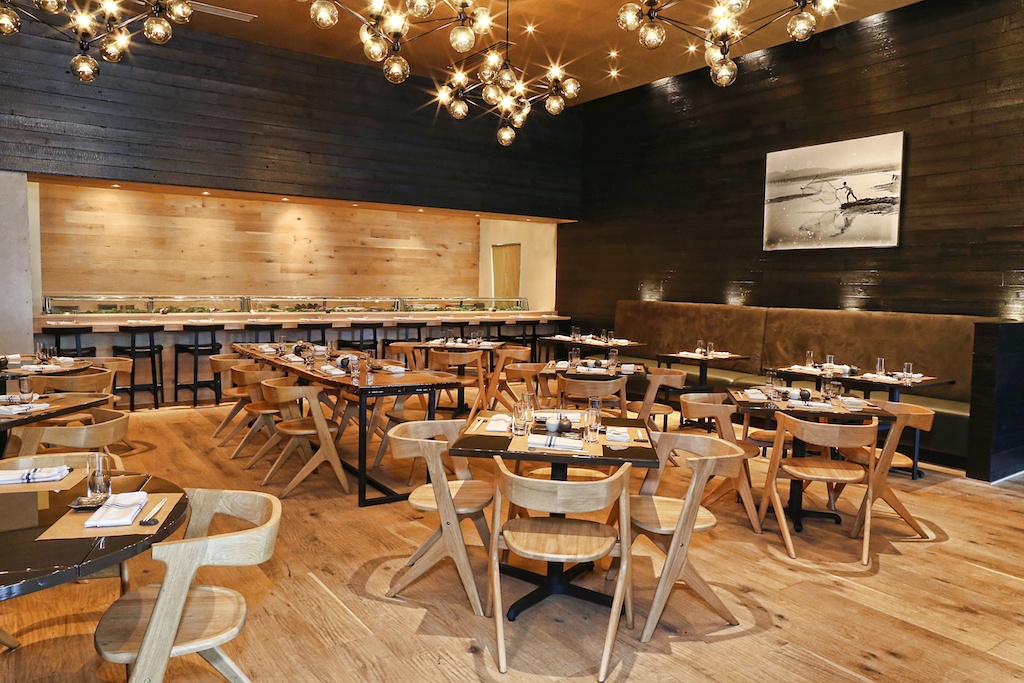 make this a snazzy place
whose look was to be at least as important as the
food. Unlike most sushi eateries, Umi has a very large
dining room: to the rear is the sushi bar; the vast
dark walls are hung with huge works of art. Part
of the intent, annoyingly, was to create an
environment where earsplitting noise is supposed to
create excitement, when in fact it is more
than off-putting. Indeed, it was really
one of the loudest restaurants I dined in all last
year, which obliterated much of the pleasure of Ito’s
exquisite omekase
menus.
make this a snazzy place
whose look was to be at least as important as the
food. Unlike most sushi eateries, Umi has a very large
dining room: to the rear is the sushi bar; the vast
dark walls are hung with huge works of art. Part
of the intent, annoyingly, was to create an
environment where earsplitting noise is supposed to
create excitement, when in fact it is more
than off-putting. Indeed, it was really
one of the loudest restaurants I dined in all last
year, which obliterated much of the pleasure of Ito’s
exquisite omekase
menus.
Our large party left the omekase all up to
Ito, beginning with appetizers of yellowtail with
jalapeño and ponzu sauce; salmon yuzu; and tuna
carpaccio, whose bright flavors and seasonings set the
palate for the cool, unadorned purity of unstintingly
fresh sashimi---yellowfin tuna, yellow jack, kinmedai (sea
bream), otoro, madai
(red snapper) and amaebi sweet shrimp.
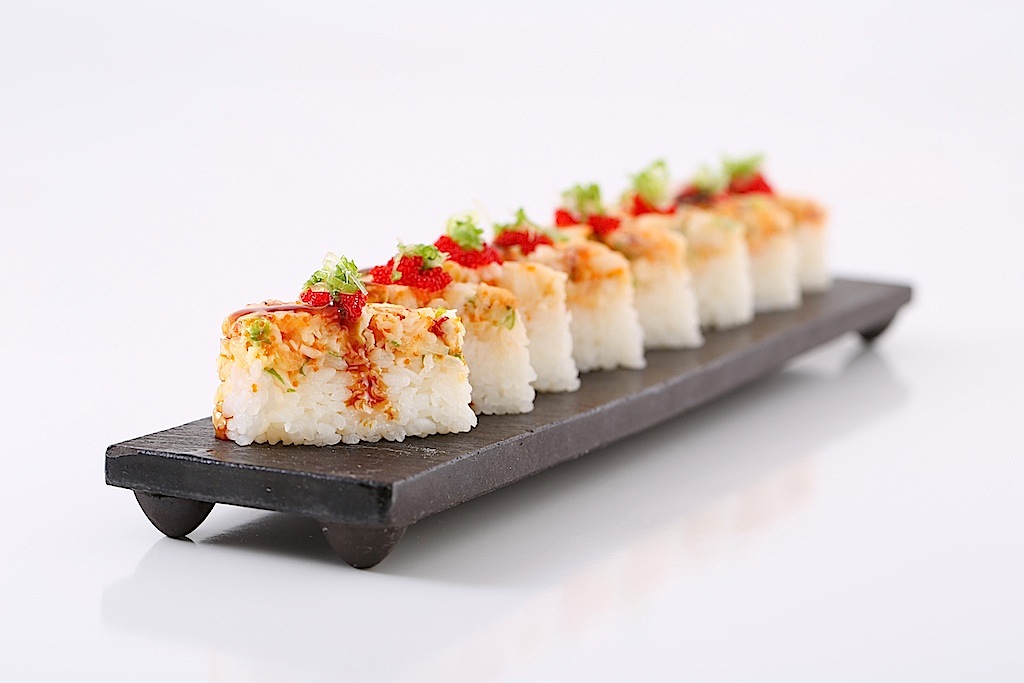 Nigiri sushi followed, the
flavor and temperature of the rice as important as the
seafood, which included uni-aburi (sea urchin), otoro, zuke-maguro tuna,
shime-saba
(marinated mackerel), kinmedai (golden-eye red snapper),
and mako-karei
(halibut).
Nigiri sushi followed, the
flavor and temperature of the rice as important as the
seafood, which included uni-aburi (sea urchin), otoro, zuke-maguro tuna,
shime-saba
(marinated mackerel), kinmedai (golden-eye red snapper),
and mako-karei
(halibut).
The presentation of the warm dishes
was pretty without ostentation, and it was unusual to
see foie gras two ways – nigiri-style, with fresh wasabi and
soy sauce, and with teriyaki sauce and radish sprout,
which went well with a 2009 Château
Villa-Franche Sauternes. Black cod miso-yaki,
Chilean sea bass yu-an
yaki (marinated and grilled) and rock shrimp
with creamy spicy sauce followed.
I was getting a bit full by then
but still to come were irresistible scallops seared on the grill, as was
lobster with 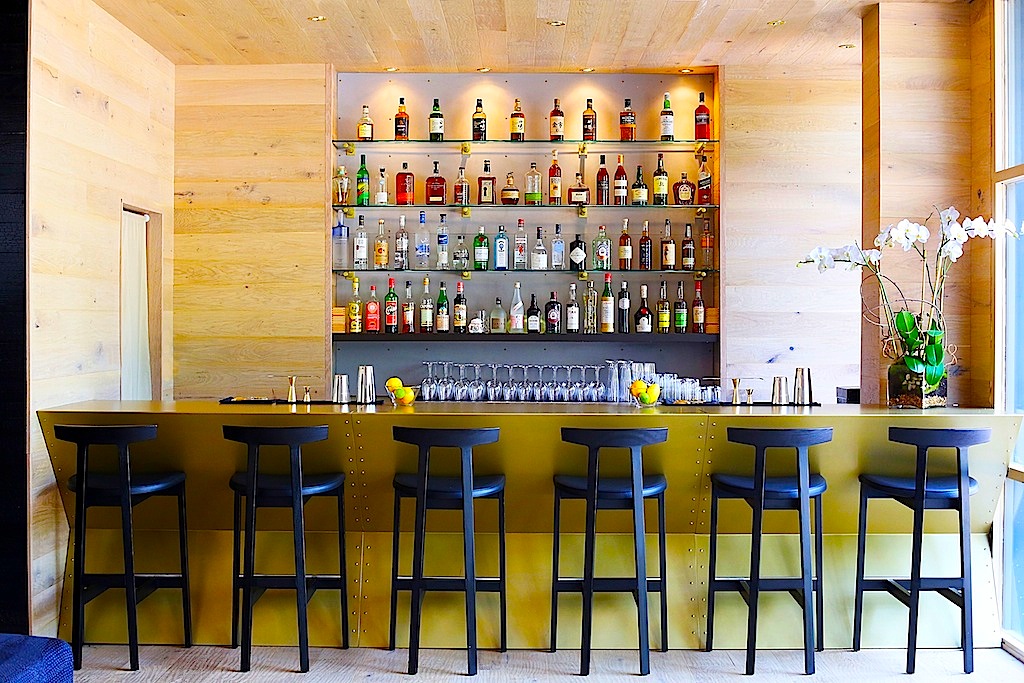 soy butter, and, the piéce de
résistance--or coup de grace--Kobe-beef toban-yaki in a
dashi broth that ameliorated the decadent richness of
the beef, which at $28 an ounce is sheer indulgence;
then again, this is the true Japanese Kobe beef, not
Australian or Texan “Kobe-style,” and that makes a
great deal of difference.
soy butter, and, the piéce de
résistance--or coup de grace--Kobe-beef toban-yaki in a
dashi broth that ameliorated the decadent richness of
the beef, which at $28 an ounce is sheer indulgence;
then again, this is the true Japanese Kobe beef, not
Australian or Texan “Kobe-style,” and that makes a
great deal of difference.
The
translation of Japanese food culture into western
desserts is rarely very successful, though I admired
chef Lisa Ito’s honorable marriage in items like green
tea soufflé with Cointreau anglaise sauce;
and a chocolate pecan pie with Japanese sea salt
caramel.
Umi at its best, which is at the
sushi counter away from the noise, brings back
memories of the fine work Ito did at MK, only now it
seems even more personalized and entirely his.
Open for dinner Mon.-Sat.; prices vary tremendously depending if you order a la carte or tasting menus, as do seafood prices of top quality.
DAVIO'S
Phipps Plaza
404-844-4810
davios.com/atl
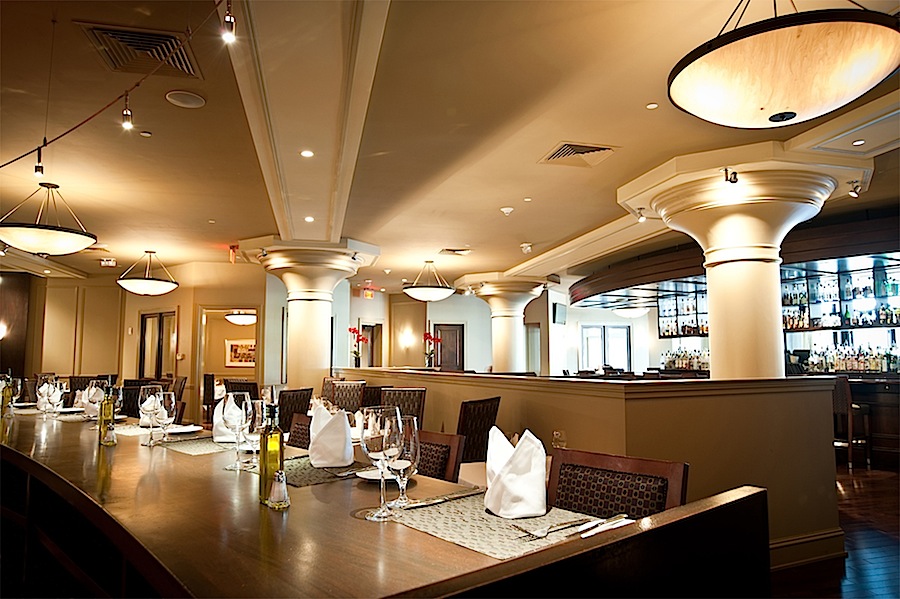 Atlanta
has two top-tier indigenous steakhouses--Bone’s and
Chops--along with the usual national chains, so
Davio’s had to go several steps further to distinguish
itself among the cookie-cutter competitors. Since
opening the original Davio’s in Boston, owner Steve
DiFillippo has had considerable success capitalizing
on the Italian steakhouse theme with branches in
Foxborough and Lynnfield, MA, Philadelphia, Atlanta,
and, last fall, in NYC.
Atlanta
has two top-tier indigenous steakhouses--Bone’s and
Chops--along with the usual national chains, so
Davio’s had to go several steps further to distinguish
itself among the cookie-cutter competitors. Since
opening the original Davio’s in Boston, owner Steve
DiFillippo has had considerable success capitalizing
on the Italian steakhouse theme with branches in
Foxborough and Lynnfield, MA, Philadelphia, Atlanta,
and, last fall, in NYC.
First of all, the Atlanta design
departs from the cliché-ed masculinity of his
competitors, with lighter colors, good
separation between tables, and a modern polish
throughout. G-M Claude Guillaume knows how to
build a steady clientele the old-fashioned way,
through courtesy rather than the brash macho of so
many other beef eateries. The wine list is
solid, the service staff well trained, and the open
kitchen a pleasant diversion.
Davio’s is
self-described as a “Northern Italian Steakhouse,”
which means there is a far larger selection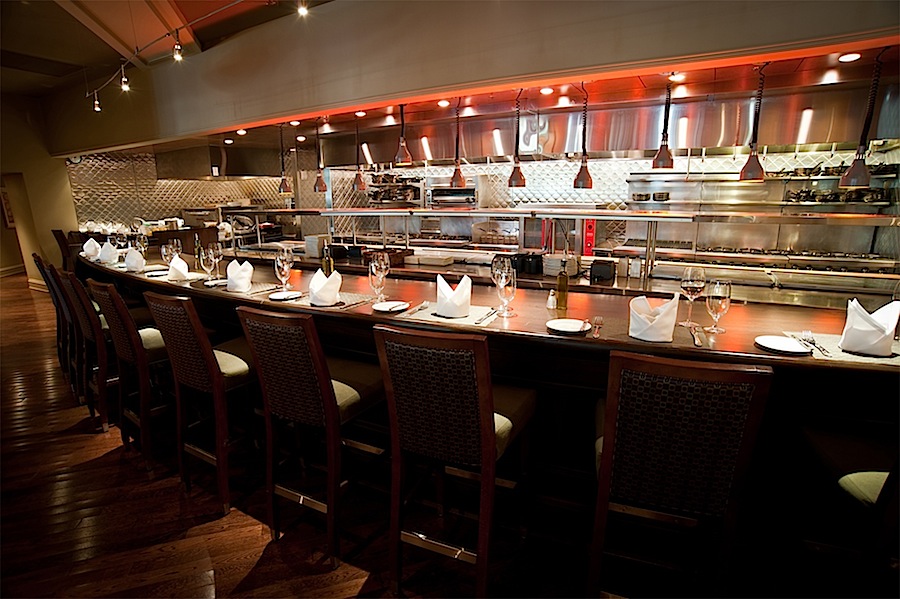 of
appetizers, or antipasti,
that includes Kobe-style meatball with tomato sauce
and caciocavallo
cheese; crispy calamari with chickpeas,
oregano and a spicy tomato sauce; and Davio’s
signature spring rolls (they sell them by the box),
which have never bowled me over, although I can see
their appeal, done up with chicken parm, Buffalo
chicken, and shrimp.
of
appetizers, or antipasti,
that includes Kobe-style meatball with tomato sauce
and caciocavallo
cheese; crispy calamari with chickpeas,
oregano and a spicy tomato sauce; and Davio’s
signature spring rolls (they sell them by the box),
which have never bowled me over, although I can see
their appeal, done up with chicken parm, Buffalo
chicken, and shrimp.
All pastas
are available in appetizer portions, and there is
exceptional range--from fresh, light potato gnocchi with organic
mushrooms and a fragrant basil truffle oil to lobster
risotto with asparagus and lobster cream. The
tagliatelle bolognese has a fine, lusty
meat-and-tomato sauce, though it would hardly pass
muster for authenticity in Bologna.
You
could, therefore, easily go to Davio’s even if you had
no particular interest in steaks, for the menu also
lists a massive grilled 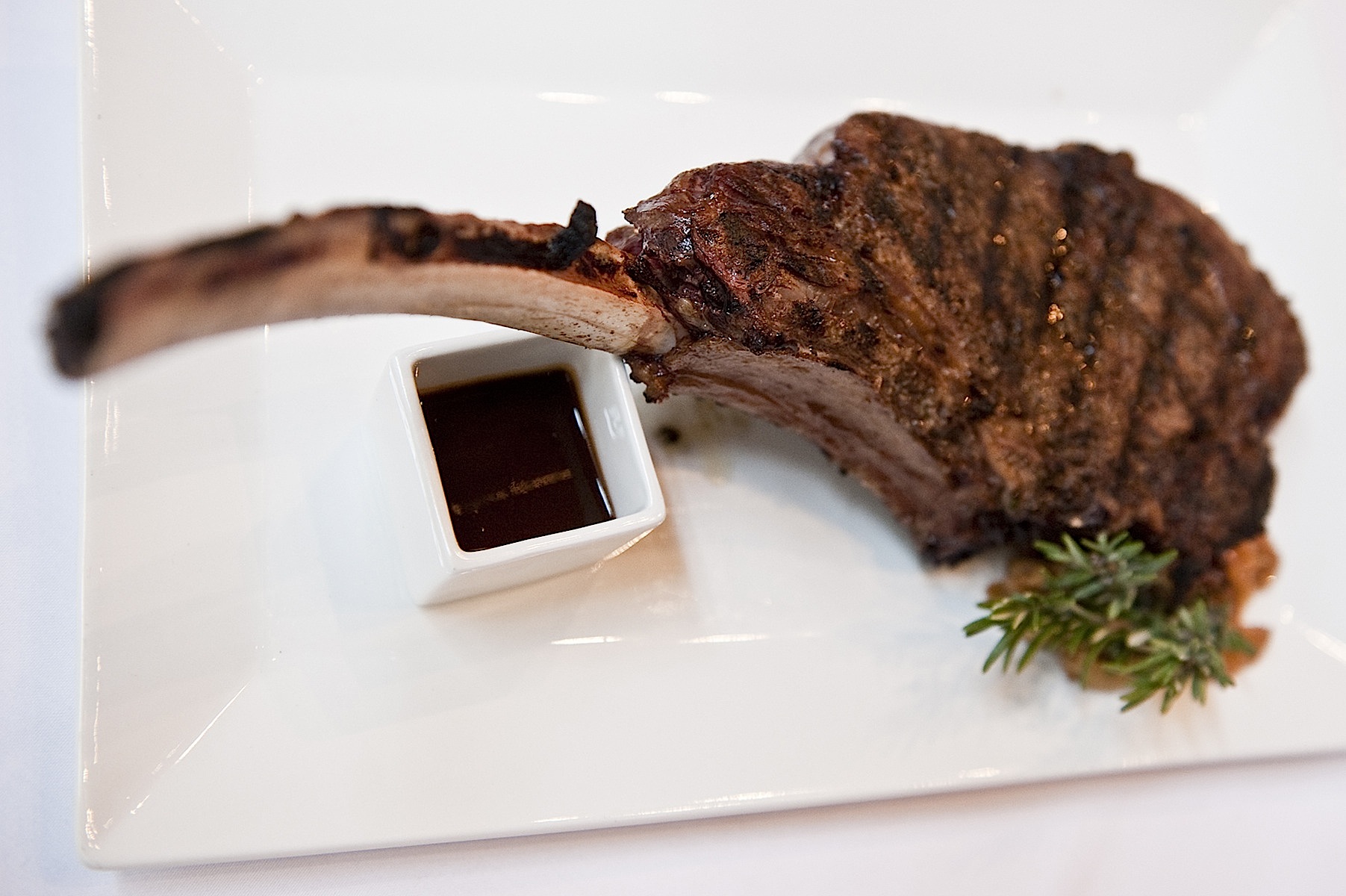 porterhouse of
veal with creamy potatoes, asparagus and a Port wine
sauce, as well as pan-seared scallops with Carolina
Gold Rice grits, leeks and basil oil. Slowly
braised beef short ribs are gilded with Gorgonzola
mashed potatoes, Swiss chard and a Port wine
glaze.
porterhouse of
veal with creamy potatoes, asparagus and a Port wine
sauce, as well as pan-seared scallops with Carolina
Gold Rice grits, leeks and basil oil. Slowly
braised beef short ribs are gilded with Gorgonzola
mashed potatoes, Swiss chard and a Port wine
glaze.
If, however, you do come to see how
the beef stacks up next to Atlanta’s other
steakhouses, you will be very happy with the USDA
Prime offerings here, especially the terrific New York
sirloin and the ribeye. You’ll also be delighted with
the Colorado lamb chop of real succulence and rich
mineral flavors. Throw in some onion rings or
macaroni and cheese with white truffle oil, and you’re
going to be impressed.
And while Davio’s main course
prices are competitive with those of its competitors,
Davio’s candidly lists theirs on their website while
most of the others do not. So, in trying to
distinguish Davio’s from the rest, they are trying
hard to win you over and win you away. And a
little pasta doesn’t hurt that idea
either.
Open daily for lunch and dinner. Appetizers $9-$16;
pastas $18-$32; main courses $26-$45.
CHAI PANI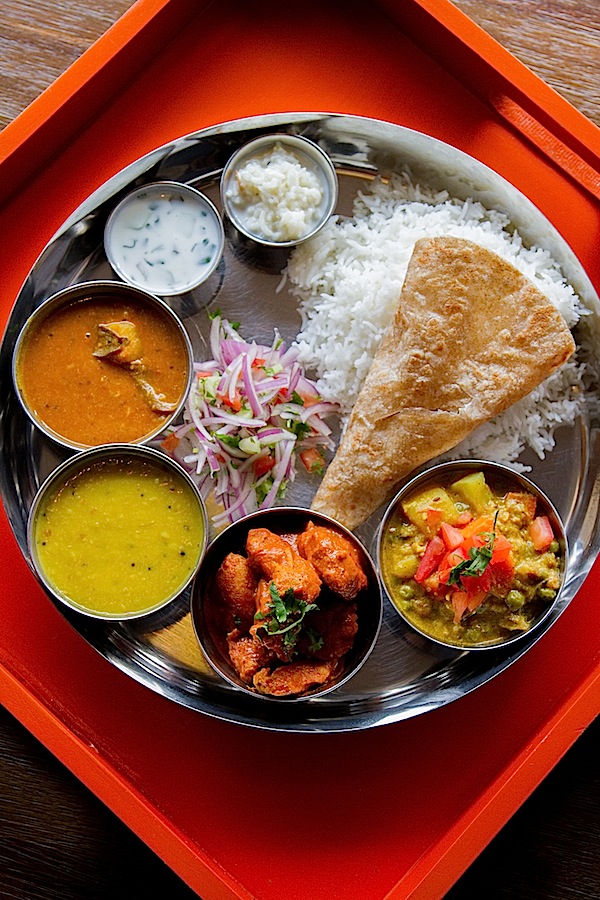
406 West
Ponce de Leon Avenue
Decatur, GA
chaipanidecatur.com
Decatur,
Georgia, is an easy 20-minute drive outside of
Atlanta and, in a much smaller way, is itself
becoming something of a food destination. Chai
Pani--which means “tea and water,” but in India
colloquially refers to going out for a snack--is a
truly delightful addition to the increasing number of
Indian restaurants in the USA that are going well
beyond tandoori chicken and mulligatawny soup.
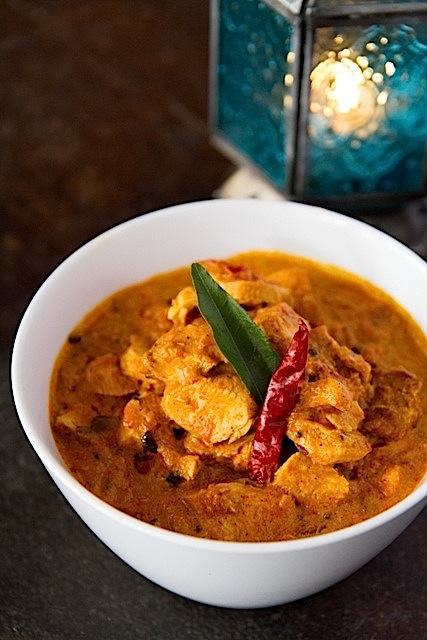 The original
Chai Pani was opened by Chef Meherwan Irani and his
wife, Molly, in Ashville, NC, with Decatur’s branch
debuting last year. The menu features regional
Indian street food--the kind guidebooks wisely
encourage foreign travelers to India not to eat if
they want to avoid “Delhi belly.” But here in Decatur,
be assured you will have the time of your life and
remember each dish with every intent to return soon
for more.
The original
Chai Pani was opened by Chef Meherwan Irani and his
wife, Molly, in Ashville, NC, with Decatur’s branch
debuting last year. The menu features regional
Indian street food--the kind guidebooks wisely
encourage foreign travelers to India not to eat if
they want to avoid “Delhi belly.” But here in Decatur,
be assured you will have the time of your life and
remember each dish with every intent to return soon
for more.
The menu is long, beginning with chaat (snacks)
like kale pakora,
so piping hot and crispy they seem to crackle before
you even eat them. So, too, the okra fries are tossed
with lime and spices before a deep plunge into hot
oil. The samosas
with garbanzo beans, sweet yogurt, tamarind and green
chutney are so good I’d take them in a bag to nosh on
during a tailgate picnic, and addictive indeed is the
platter of Sev
potato dal puri
with crunchy chickpea noodles. Uttapam are
savory crêpes made with a lentil batter, like a
flat dosa
heavy with a stew of cheese, while the Sloppy Jai
here is done with a lamb hash, tomato, onions
and all manner of complex spices, served on two soft
buns. They also do traditional thali platters (above, right), both
vegetarian and non-vegetarian.
Chai Pani is one of those
restaurants where no matter how many things you try,
somehow you don’t feel stuffed. But you
eventually will, which only means you'll be back
for more, and probably very soon.
Open Tues.-Sun.;
Snacks $3.49-$7.99; uttapam $9.99; sandwiches
$8.99-$9.99.
❖❖❖
]
]
NEW YORK
CORNER
Minton's
and
The
CecilE
CECIL
By John Mariani
Photos by Evan Sung

I
shall
let my brother Robert fill you in on the
background and future of Minton’s (see next story),
which, with its adjacent restaurant The Cecil
(both
at 206
West 118th Street), is part of the new
Harlem Restaurant Renaissance that also includes
Red Rooster, the 5 and Diamond, Corner Social
and Vinateria. Let me concentrate on the
restaurant segment of Minton’s and begin by
saying that it is certainly one of the most
handsome 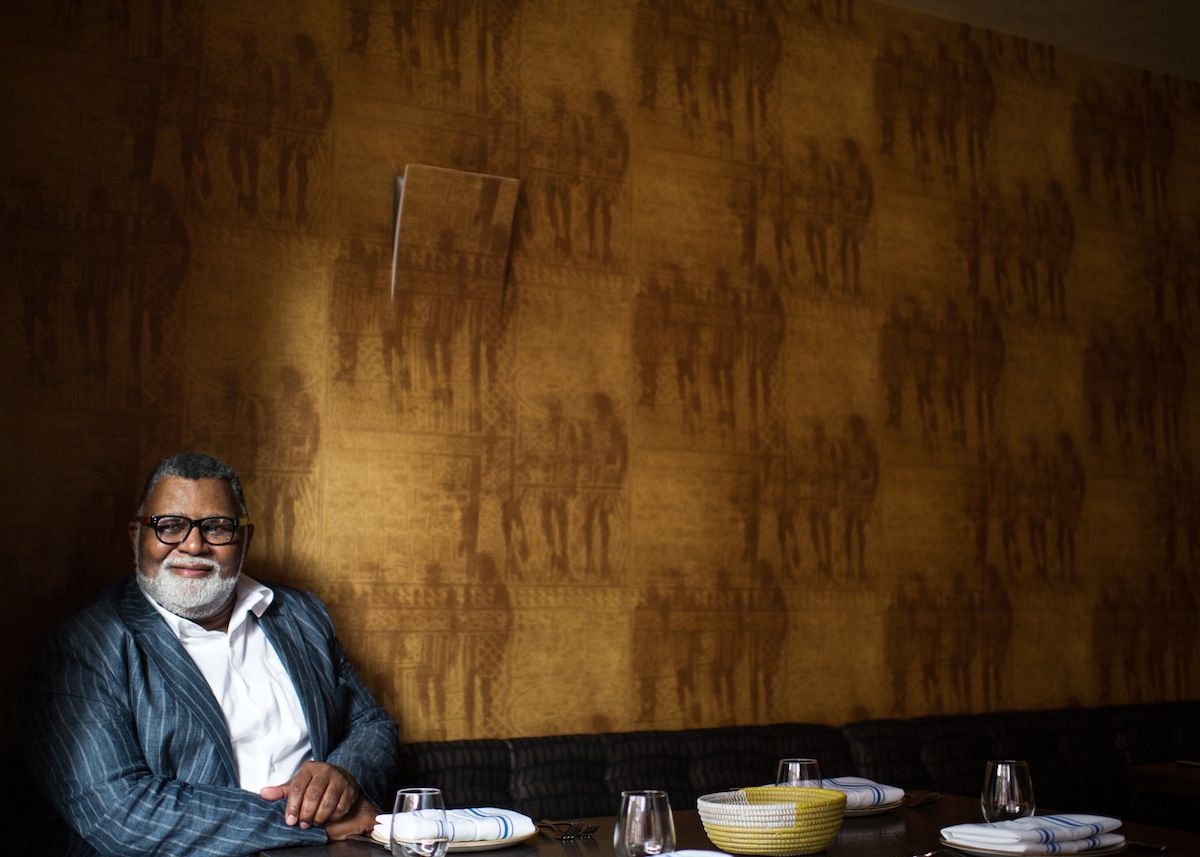 new
restaurants to open this year, right down to the
white tablecloths.
new
restaurants to open this year, right down to the
white tablecloths.
Founded in 1938 by saxophonist Henry Minton, the
“playhouse” was the crucible of jazz that came to be
called bee-bop, whose innovators included giants
like Thelonious Monk, Dizzy Gillespie, Charlie
Parker and Charlie Christian. Minton’s was
going strong until 1974, when a fire razed the hotel
in which it was located, and, through those dark
days of Harlem’s history, Minton’s stayed dark.
Happily for everyone, Minton's
(212-243-2222)
has new owners and a smashing new look in a
modest-sized room whose antecedent was listed on both the National and the
New York State Register of Historic Places.
Huge photos of jazz stars bring back the
memories, as does a house band of stellar musicians,
and the respect paid by owner Richard Parcels
and partner-chef Alexander Smalls (right) to the
traditions of Harlem cookery--they call it “Southern
Revival Cooking”--is evident on a menu that includes
a lavish “Low Country Experience” of appetizers:
Beau Soleil oysters with Champagne mignonette and
osietra caviar; deviled egg toast with smoked trout
and pickled shallots; fried okra and country ham;
blue crab fritter with sauce rouille; a lusty bacon
pilau with smoked chipotle aïoli; and cremini
mushrooms with creamed collard greens ($24).
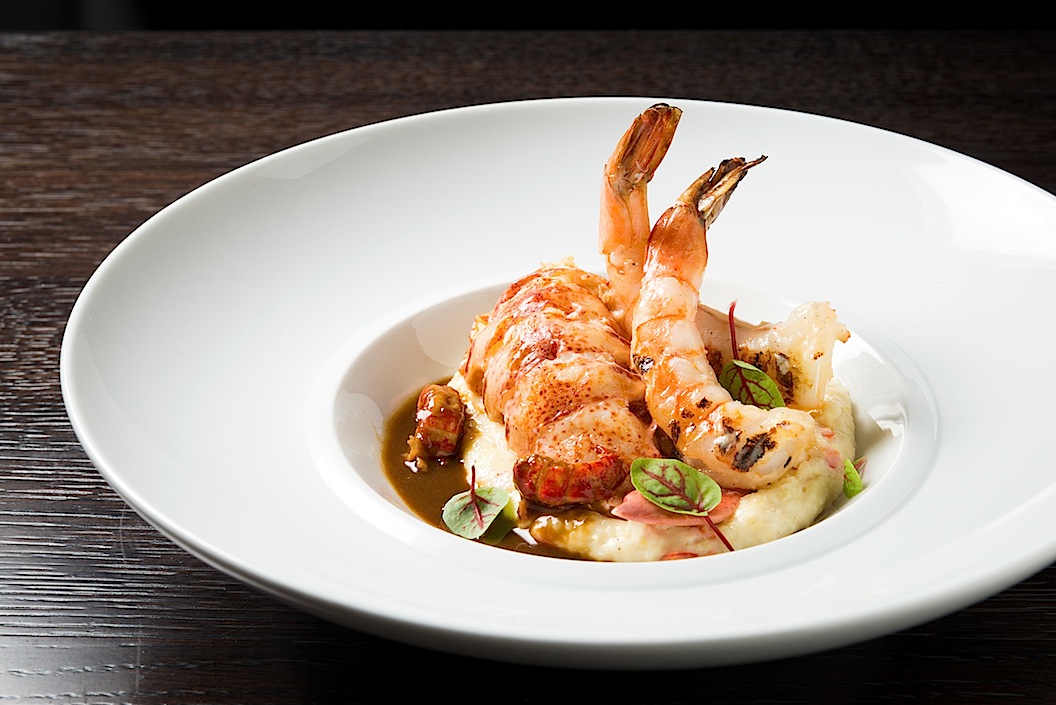 Other fine starters
include a tangy sherried she-crab soup with crispy
yams and skillet bread ($18) and a roasted parsnip
and kabocha squash soup with benne seed crunch and
brown butter crème fraîche ($14).
Other fine starters
include a tangy sherried she-crab soup with crispy
yams and skillet bread ($18) and a roasted parsnip
and kabocha squash soup with benne seed crunch and
brown butter crème fraîche ($14).
Among the main
courses, I recommend the smoked Berkshire pork chop
with a yam hominy grit cake and winter greens ($39),
which shows a refinement of country cooking for
which chef de cuisine Banks White shows real talent.
Plump quail is also smoked, served with a
giblet cornbread cake and cranberry cardamon cake
($34). A generous casserole of lobster and shrimp
comes with a rich Creole crawfish gravy and pimento
cheese grits (left).
And you will not easily forget the fabulous,
if misshapen, flaky Southern biscuits at Minton’s,
which are a dazzling riff on culinary tradition as
much as bee-bop was on New Orleans
jazz. On the
busy Saturday night I visited, some of the dishes
were not up to others, and some came out tepid, not
hot, perhaps owing to a menu unnecessarily large for
this size restaurant. I trust the kitchen will
get into the swing of things and coordinate all the
cooking with more finesse.
For dessert the
best is a pineapple upside down cake with corn cream
and a blueberry compote.
Just a few yards away from
Minton’s is The
Cecil (212-866-1262), whose piped-in
background music indicates that this is more of a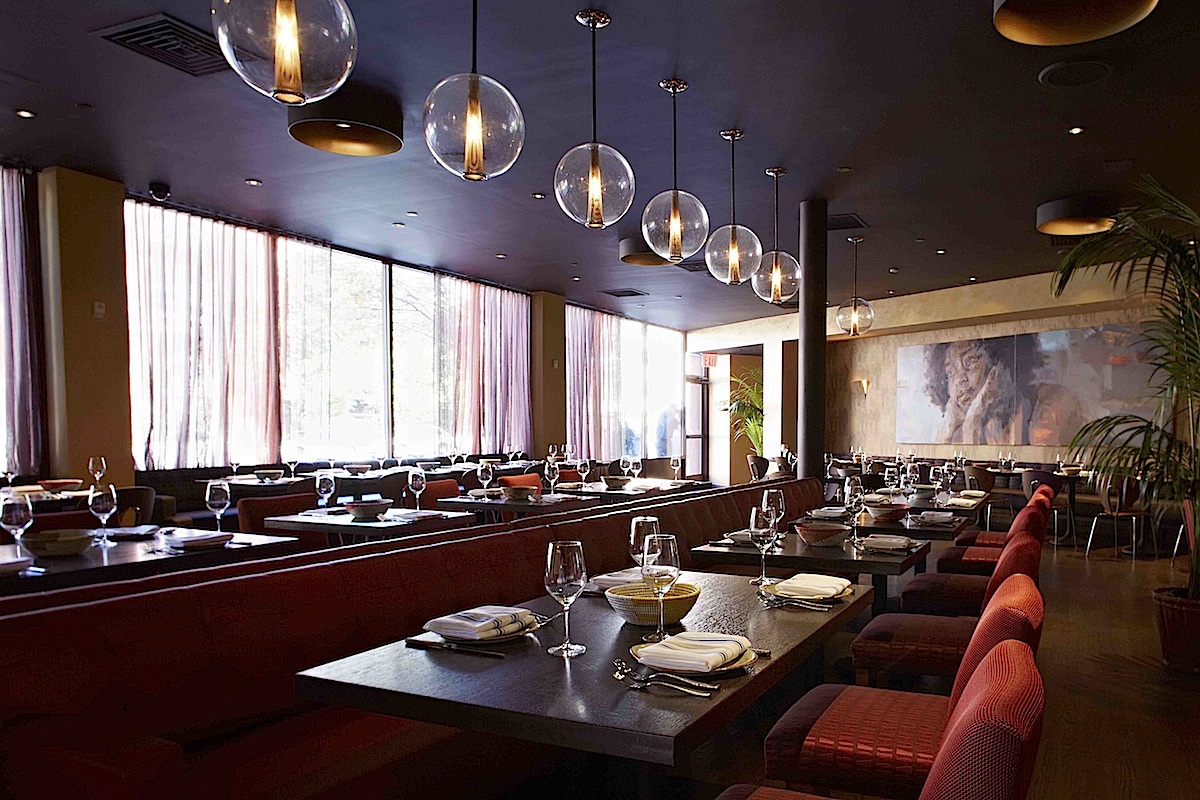 restaurant than a jazz
venue. Here, Smalls, with Chef de Cuisine Joseph
“JJ” Johnson, are doing what they call the “comfort food of the African
Diaspora,” so that you may roam from a delicious
West African beef suya with rum-soaked apricot compote,
grilled plantains and groundnuts to Gullah shrimp
min-burgers with housemade kimchi and scallions.
restaurant than a jazz
venue. Here, Smalls, with Chef de Cuisine Joseph
“JJ” Johnson, are doing what they call the “comfort food of the African
Diaspora,” so that you may roam from a delicious
West African beef suya with rum-soaked apricot compote,
grilled plantains and groundnuts to Gullah shrimp
min-burgers with housemade kimchi and scallions.
I arrived at
The Cecil with three very hungry guys, finding the
bar up front bopping. A beautiful and wholly engaging
Haitian-born manager named Paola Mathe brought us to
our table and checked back all night. Our cocktails
were impeccably rendered, and we began ordering from
every section of a long menu. A white root
vegetable soup was laced with red curry oil and
chives ($9), and a black bottom bean cake came with
a fruity-spicy papaya salsa and plantain chips
($11). “Afro/Asian/American” oxtail dumpling were
spiked with a green apple curry sauce and crispy
taro root ($14) for scooping up the sauce, and the
spicy broiled prawns (below, right)were gigantic indeed,
with a yam flapjack and piri piri sauce ($15).
There is a section called the “rice & vegetable
wok bar,” (below,
left) from which you choose your preferred
rice—black, jasmine, sweet brown—and top it with an
array of options. We went with succulent country cut
pork ribs ($24) and left not a morsel behind.
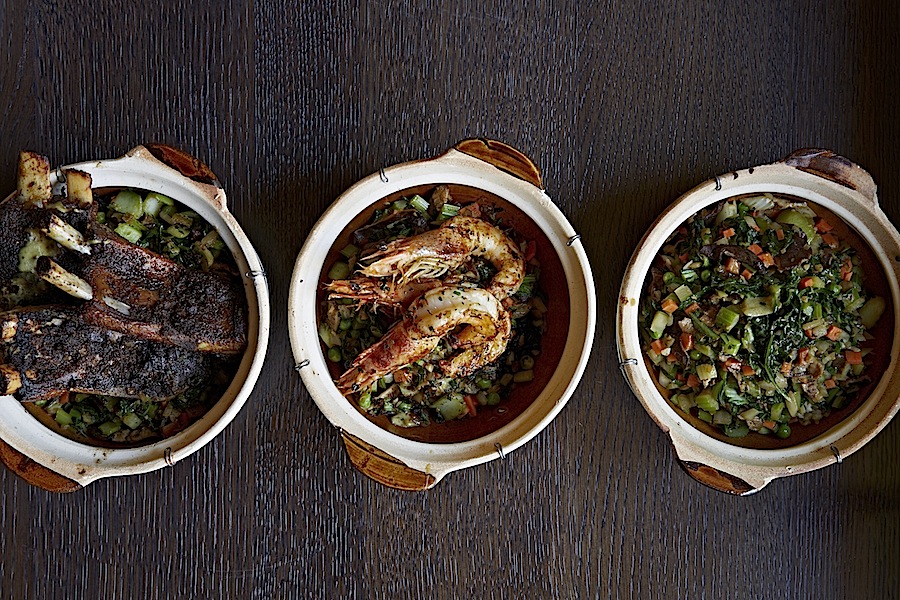 There was a slew of
wonderful main courses, including a macaroni and
cheese casserole ($16) with caramelized shallots and
pepper ham, and feijoada,
the beloved dish of Brazil bulked up with spicy
black beans, oxtail, merguez lamb sausage ($27).
There was a slew of
wonderful main courses, including a macaroni and
cheese casserole ($16) with caramelized shallots and
pepper ham, and feijoada,
the beloved dish of Brazil bulked up with spicy
black beans, oxtail, merguez lamb sausage ($27).
Long-braised
lamb shank fell off the bone, accompanied by coconut
grits, heirloom carrots and purple sweet potato
($36), while duck fried noodles gained enormous
flavor from a collard greens salsa verde, cashew
broth and a poached egg on top ($32).
If,
after having food this hearty, you have room for
just one dessert, make it the pecan sticky buns with
brown butter toffee and vanilla ice cream ($8)—and
two forks. Then again, there’s everything to love
about the spiced Nyangbo crema sponge cake,
chocolate croquante, and black cardamon ice cream
($8).
Perhaps
what’s most impressive about the menu here is that
you won’t find a single item on it served anywhere
else in New York City. Every dish is very
special, some unique, and a great deal of thought
has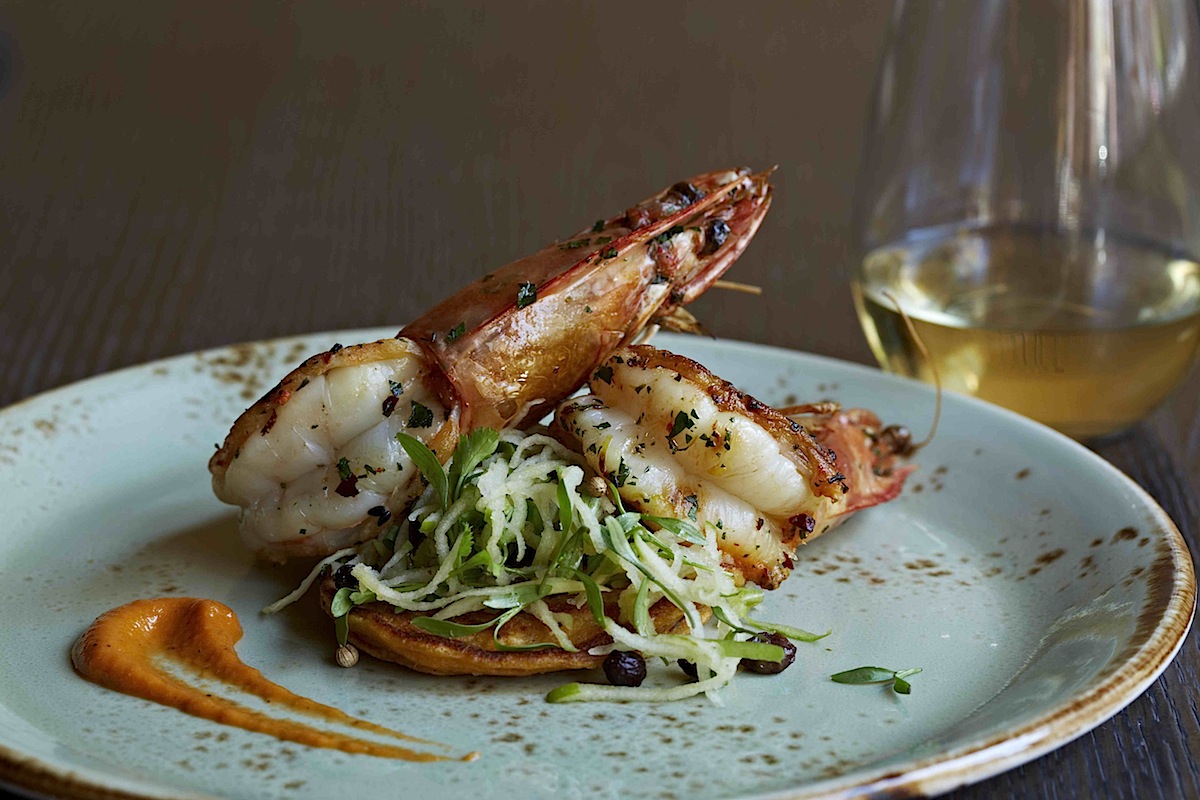 gone into exotic
seasonings here.
gone into exotic
seasonings here.
Indeed,
if I may indulge a backhanded compliment to JJ
Johnson, it’s that, if you take food home—and you
will—some dishes lose a great deal in taste and
texture when consumed the next day, meaning that his
cooking is not just fresh but depends on a very
canny timing and devotion to each ingredient in a
dish. Like pizza and French fries, they need to be
consumed on the spot.
The
Cecil’s roomy space, with a fine mural of a black
woman, has tables made for piling on dishes, and the
noise level is civilized. Bread baskets and
bowls evoke those from home kitchens. Some of
the well-meaning waitstaff need more tutoring about
the wine list, but overall I think it impossible
that anyone going to The Cecil will be disappointed
with the vibe and perhaps educated in the most
savory way of the breadth and depth of The Cecil’s
style of cooking.
Minton's is open
Wed.-Sun. for dinner; The Cecil is open for lunch
Mon.-Fri.; for brunch Sat. & Sun.; for dinner
nightly.
. . . AND AN
ICONIC JAZZ HAVEN IS BORN AGAIN
By Robert Mariani
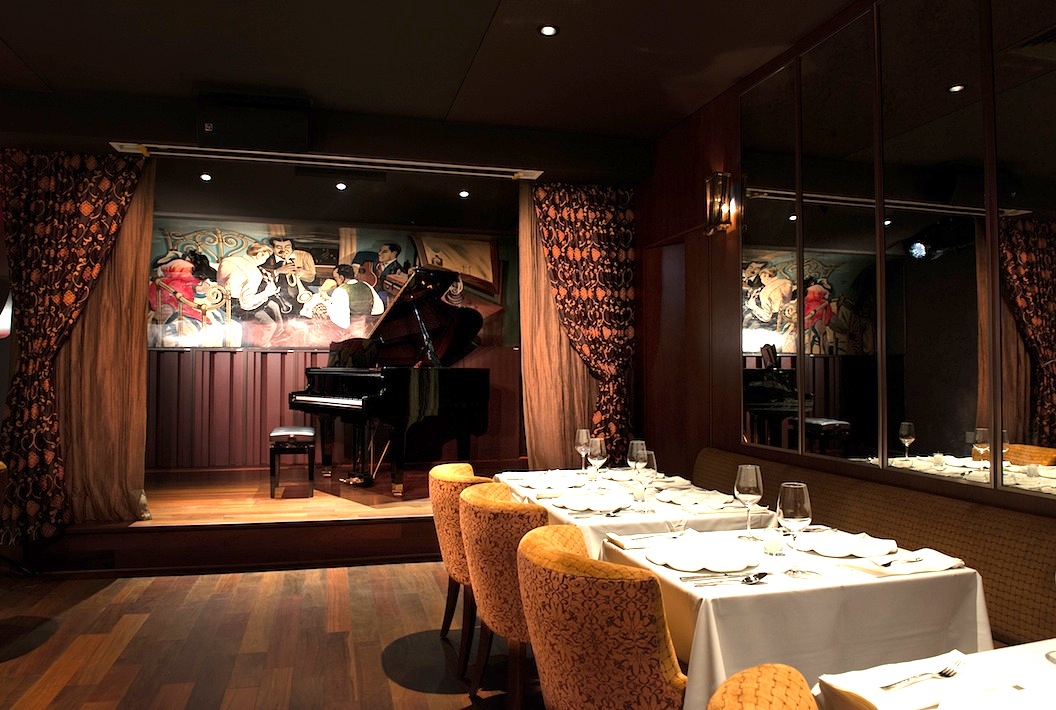 It’s a
name I don’t think I’ve heard spoken of in many
years.
It’s a
name I don’t think I’ve heard spoken of in many
years.
And so when I learned that after
many years, “Minton’s Playhouse” was re-opening at
its original address at West 118th
Street in Harlem on the ground floor of the old
Cecil Hotel, I was really delighted. Delighted that
the unassuming little nightclub where Bird and Diz’
and Monk and the rest of the greats and near-greats
all went to jam was back in business after a fire in
1974 had shut it down.
Although I grew up in the Bronx
then lived in mid-town Manhattan for over ten years
in the late ‘60’s, I’d never gone to Minton’s.
Birdland, the Five Spot, The Jazz Gallery, The Blue
Note, The Half Note, Slug’s, Sweet Basil, and the
Village Vanguard were all the great jazz venues I
was lucky to frequent. But never Minton’s. It was
not very highly publicized at the time and there was
little if any music of note being played there in
the late '60s and '70s.
But now, Minton’s Playhouse is
back up and running. The space retains its original
diminutive, intimate size with narrow tables on
either side facing the wall (not the bandstand as
with the original Minton’s). The dark, film noir
atmosphere is a lot more stylish and formal than
what I imagine it probably was like back in the
‘40’s and 50’s. There are classic life-size
black-and-white photo murals of the very greatest of
the Jazz Greats—Miles and Ella and Dizzy, Lady Day
and Monk, Prez, and of course, Bird.
Behind the bandstand, the
original colorful mural depicting a small bunch of
Be-boppers lolling around in a cramped room has been
carefully restored.
On
the Saturday evening we were there, a
smartly-dressed quintet of older musicians were
playing what one might call “easy listening jazz.” It was
pretty, melodic, though not very much like the high-
intensity Bop tempos that Bird or Dizzy would have
been playing. Nobody called “Cherokee”
or “Salt Peanuts.”
It was
pretty, melodic, though not very much like the high-
intensity Bop tempos that Bird or Dizzy would have
been playing. Nobody called “Cherokee”
or “Salt Peanuts.”
The patrons this Saturday night
were talking and eating and the music was quite
literally background. Luckily though the acoustics
and the sound system were both quite good and even
though our table was a fair distance from the
bandstand, it was possible, for the most part, to
listen and appreciate the music that was being
played.
The band members were 90-year-old
Rudy Lawless on drums, Michael Max Fieny on bass,
Mike Camola on alto, Michael Howell on guitar, and
the elegant Mrs. Bertha Hope on a sparkling new baby
grand piano (below).
For me, Bertha Hope’s graceful
solos were well worth the price of that evening’s
admission, and after the set I had a chance to speak
briefly with her backstage. She seemed surprised
that someone actually new the name “Hope” and
associated it with some of jazz’s finer piano
playing moments.
Left: Thelonious Monk,
Howard McGhee, Teddy Hill, Roy Eldridge outside
Minton's Playhouse (photo by William Gottlieb)
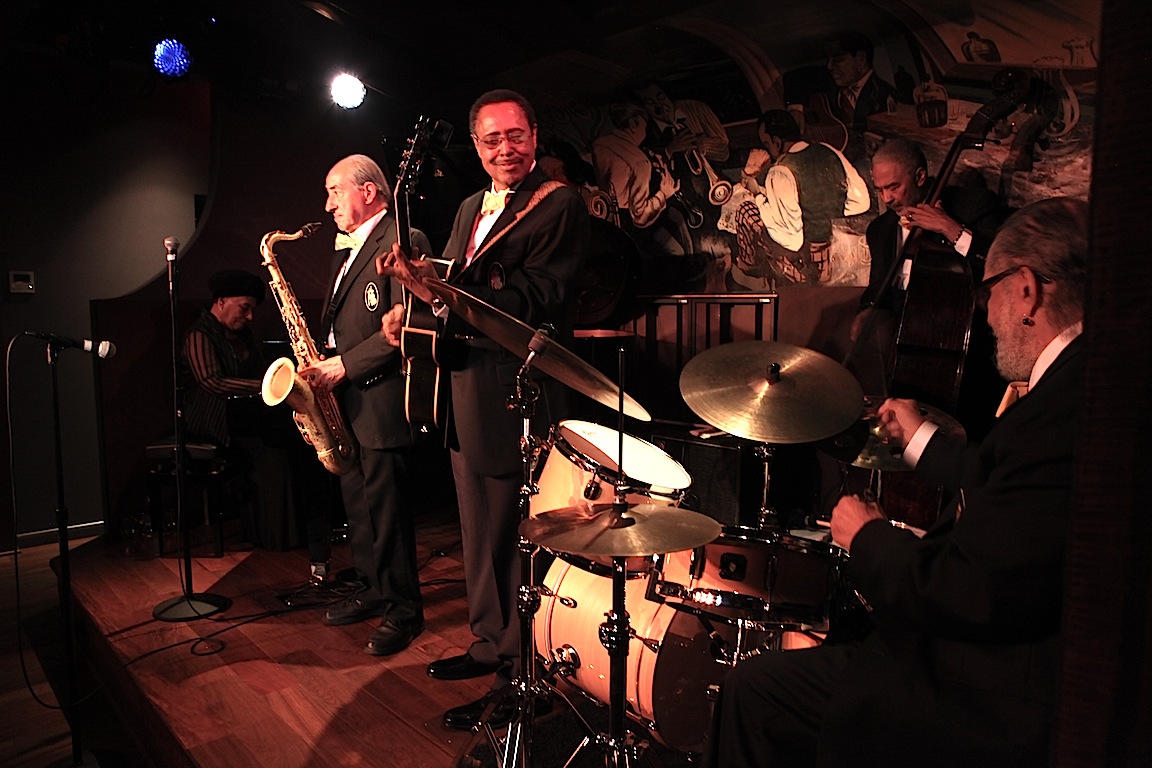 Elmo
Hope
was born in 1923 in New York City, where he grew up
with musicians like Bud Powell, Johnny Griffin,
Percy Heath and Philly Joe Jones, and later was a
side man with Sonny Rollins, Coltrane, Clifford
Brown and Harold Land.
Elmo
Hope
was born in 1923 in New York City, where he grew up
with musicians like Bud Powell, Johnny Griffin,
Percy Heath and Philly Joe Jones, and later was a
side man with Sonny Rollins, Coltrane, Clifford
Brown and Harold Land.
Elmo’s wife, Bertha, was born in
California and began taking piano lessons at about
the age of three. It was Bud Powell’s playing that
hooked her into the jazz idiom, and she was becoming
a sought-after pianist in the ‘50’s when she met
Elmo. They did record two piano albums together, but
Bertha put her own career on hold as the spotlight
began to shine more brightly on her husband. He was
one of the pianists just about everyone back then
liked playing with.
Listening to Bertha Hope that
night at Minton’s reminded me what if feels like to
just relax into the groove the way that the great
players have always done. Her velvety touch on the
keyboard is not unlike that of Hank Jones's, and
though it’s easy to hear how much she was influenced
by the whirlwind of originality surrounding her
during the growth of Be-Bop, she maintains her own
conception, her own sound, her own time feeling that
really and truly swings. If anyone belongs at the
new Minton’s Playhouse today, it is the musically
beautiful Bertha Hope.
❖❖❖
NOTES FROM THE WINE CELLAR
PRESTIGE
CUVÉE CHAMPAGNES
By Brian A. Freedman
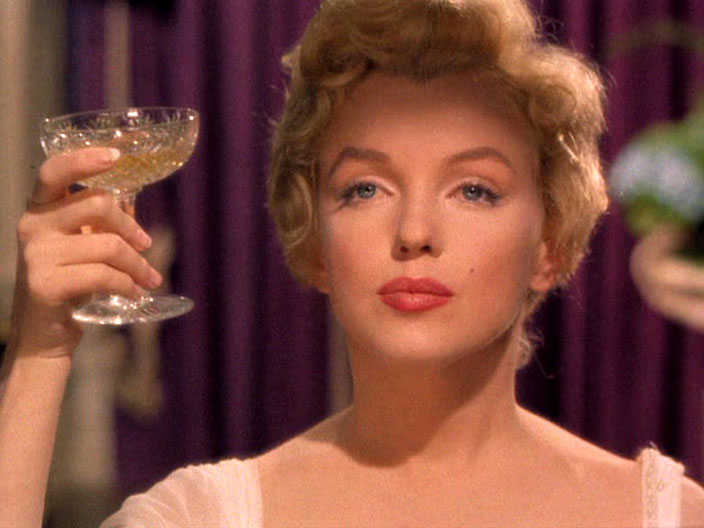 I
spend a fair amount of time at beautiful tastings and
elaborate meals for my work, and over the years it’s
gotten notably easier to convince my wife that, yes,
heading into NYC for a wine-soaked lunch or dinner is,
indeed, a necessary aspect of my job. But a recent
tasting and lunch of some of the top Champagnes in the
world, presented by renowned expert Ed McCarthy for
the Wine Media Guild's annual December
gathering, was a rare opportunity to taste and enjoy
over lunch more than a dozen and a half prestige
cuvées, those top-tier bottlings that represent
the apex of the art and craft of producing Champagne,
and to broadly assess what sets these often legendary
wines apart from their counterparts.
I
spend a fair amount of time at beautiful tastings and
elaborate meals for my work, and over the years it’s
gotten notably easier to convince my wife that, yes,
heading into NYC for a wine-soaked lunch or dinner is,
indeed, a necessary aspect of my job. But a recent
tasting and lunch of some of the top Champagnes in the
world, presented by renowned expert Ed McCarthy for
the Wine Media Guild's annual December
gathering, was a rare opportunity to taste and enjoy
over lunch more than a dozen and a half prestige
cuvées, those top-tier bottlings that represent
the apex of the art and craft of producing Champagne,
and to broadly assess what sets these often legendary
wines apart from their counterparts.
In all honesty, I felt
a little guilty leaving the house that morning. Once I
finally walked into Felidia Restaurant on East 58th
Street and saw the bottles in their buckets of ice,
however, I quickly got over it. Decadence, it
turns out, defeats guilt every time. I think Epicurus
said that. Or maybe not.
Unlike the more
readily available and affordable brut non-vintage
style, the majority of these Champagnes were
vintage-dated, expressions not just of a particularly
successful year’s crop but also, in many cases, of the
terroir of a specific part of the fabled region. And
the differences were staggering.
The youngest of the
prestige cuvées that day was the 2005 Louis Roederer
Cristal ($220). This wasn’t a fabulous year
in Champagne, but certainly a very good one, as the
tightrope balance between pear and mineral and hints
of forest floor, all well wrought and expressive,
amply demonstrate.
Jumping back to 2004,
Perrier-Jouët’s
Cuvée Belle Époque ($130-$150)
was, as always, lovely. I found it difficult not to
drink 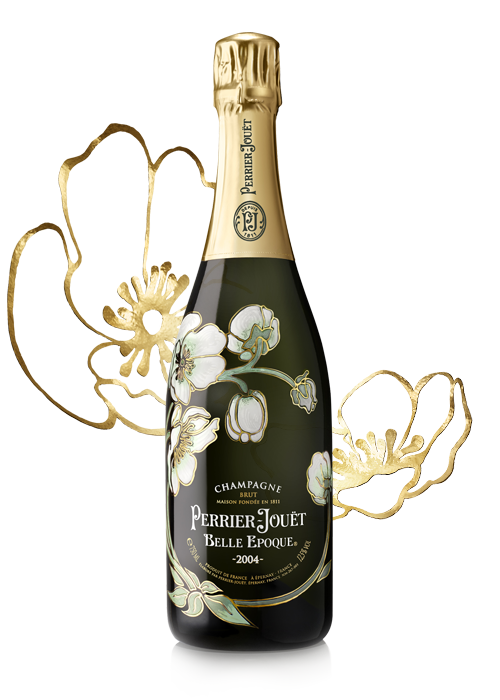 multiple glasses of this
wine with such crisp bright apple and lemon notes. (At
a wonderful lunch at Le Bernardin in October, hosted
by Perrier-Jouët and Chef de Cave Hervé
Deschamps, I loved the Belle Époque Rosé
2004, and still imagine its flowers, candied cherry,
raspberry and blood orange notes. And their 2006 Belle
Époque was a rich, exotic Champagne expressive
of nuts and warm brioche, as well as apples and
berries.) Moët
& Chandon’s Cuvée Dom Pérignon
2004 ($160-$165) boasted a nose that reminded
me of the aroma of a sidewalk after a spring rain,
with Seckel pear and hard peach and a lingering sense
of minerality. From Veuve
Clicquot, La Grande Dame 2004 ($120) spoke of
apricot, hard apple, minerals and an unexpected,
utterly charming undertone of wild strawberry.
multiple glasses of this
wine with such crisp bright apple and lemon notes. (At
a wonderful lunch at Le Bernardin in October, hosted
by Perrier-Jouët and Chef de Cave Hervé
Deschamps, I loved the Belle Époque Rosé
2004, and still imagine its flowers, candied cherry,
raspberry and blood orange notes. And their 2006 Belle
Époque was a rich, exotic Champagne expressive
of nuts and warm brioche, as well as apples and
berries.) Moët
& Chandon’s Cuvée Dom Pérignon
2004 ($160-$165) boasted a nose that reminded
me of the aroma of a sidewalk after a spring rain,
with Seckel pear and hard peach and a lingering sense
of minerality. From Veuve
Clicquot, La Grande Dame 2004 ($120) spoke of
apricot, hard apple, minerals and an unexpected,
utterly charming undertone of wild strawberry.
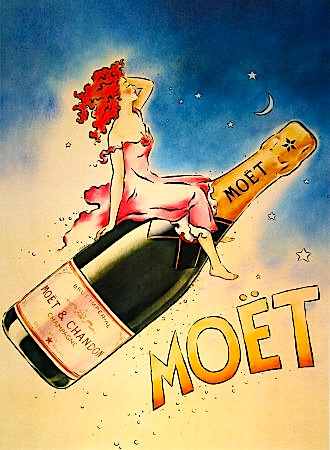 In
addition to these, I recently received two samples of
Moët &
Chandon Grand Vintage 2004--not prestige
cuvées technically, but still beautiful bottles
of Champagne. The Brut is a lively, giving bubbly that
boasts toasted biscuits, persimmon and mashed pear, as
well as attention-grabbing mineral and floral hints.
As much as I enjoyed the blanc, the Brut Rosé
is even better, with red and darker berries to spare,
as well as flowers, oranges and a hint of savory earth
at the edges.
In
addition to these, I recently received two samples of
Moët &
Chandon Grand Vintage 2004--not prestige
cuvées technically, but still beautiful bottles
of Champagne. The Brut is a lively, giving bubbly that
boasts toasted biscuits, persimmon and mashed pear, as
well as attention-grabbing mineral and floral hints.
As much as I enjoyed the blanc, the Brut Rosé
is even better, with red and darker berries to spare,
as well as flowers, oranges and a hint of savory earth
at the edges.
Heading back to
2002--an amazing year--Ayala’s Cuvée Perle
d’Ayala ($125) was one of my choice wines of
the day, its biscuit and lemon curd aromas leading to
a vigorous palate defined by its minerality and
gorgeous lemon-flesh notes. This one will continue to
drink well for another 15 years or more--not that I
can resist it right now. Also from 2002 was the lovely
Pascal Doquet
Vieilles Vignes Le Mesnil Grand Cru, a vivid
expression of one of the most highly regarded sources
for Chardonnay in France. This was all breed and
finesse, with lemon curd and high-toned minerality
pulsing with an underlying sense of power. If I had a
few bottles (and at $80-$85, I can actually afford
this one), I’d continue to enjoy them through 2030 and
beyond.
Nicolas
Feuillatte’s Palmes d’Or 2002 ($110-$120)
was a softer expression of the vintage, with mashed
pear and bright apple acidity; very appealing indeed.
Ruinart’s Dom
Ruinart Blanc de Blancs 2002 ($130), by
comparison, mined a more savory vein: white pear notes
here were balanced out by more briny flavors, an
almost salty sensation that begged for food. And Piper-Heidsieck Rare 2002
was breathtaking, a sweet-souled and rich wine with
cereal grains, biscuits, lemongrass, white flowers and
orange oil. Even at $150-$170, it’s worth the money,
if you have it. Finally with this vintage, the Perrier-Jouët Blanc
de Blancs 2002 ($150) benefited from every
one of the 60 years of age of the vines it’s produced
from: mineral, candied ginger, sweet pineapple,
brioche and a hint of sesame define this beauty.
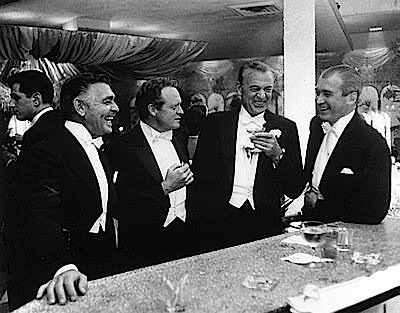 Vintage
2000 was represented here by two remarkable bottlings.
The Pol
Vintage
2000 was represented here by two remarkable bottlings.
The Pol 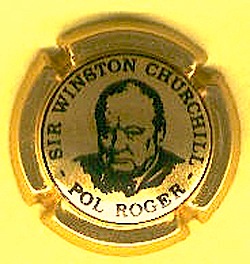 Roger Cuvée Winston
Churchill ($200-$225) was open-knit and
giving, with ample spring flowers and minerality, and,
as the chill came off it a bit, just-developing hints
of earth. This one promises to really blossom in the
next few years. From Deutz, the delicious, compact Cuvée William
Deutz ($104) reminded me of white raspberry
and crunchy Granny Smith apple, an excellent Champagne
for pairing with food other than canapés.
Roger Cuvée Winston
Churchill ($200-$225) was open-knit and
giving, with ample spring flowers and minerality, and,
as the chill came off it a bit, just-developing hints
of earth. This one promises to really blossom in the
next few years. From Deutz, the delicious, compact Cuvée William
Deutz ($104) reminded me of white raspberry
and crunchy Granny Smith apple, an excellent Champagne
for pairing with food other than canapés.
There was only one
1999 prestige cuvée at the tasting, but what a
bottling it was. I have been fortunate to taste Bruno Paillard’s Nec Plus
Ultra Grand Cru several times in the
past--once, even, at his gracious, lovely home in
Reims--and have always swooned over them. This
transfixing Champagne ($388) was no different: bright,
balanced mineral notes are lifted with more exotic
hints of lime and lemongrass, as well as emerging
forest floor. I’m already longing for the next time I
can enjoy a bottle of it.
One year older was the
Gosset
Célébris Extra Brut 1998 ($150-$160),
a wine that is carrying its age brilliantly, with
plenty of red-berry fruit mingling with notes of dulce
de leche. Wonderful. And then there was the Charles Heidsieck Blanc
des Millénaires 1995 ($175-$185). I’ve
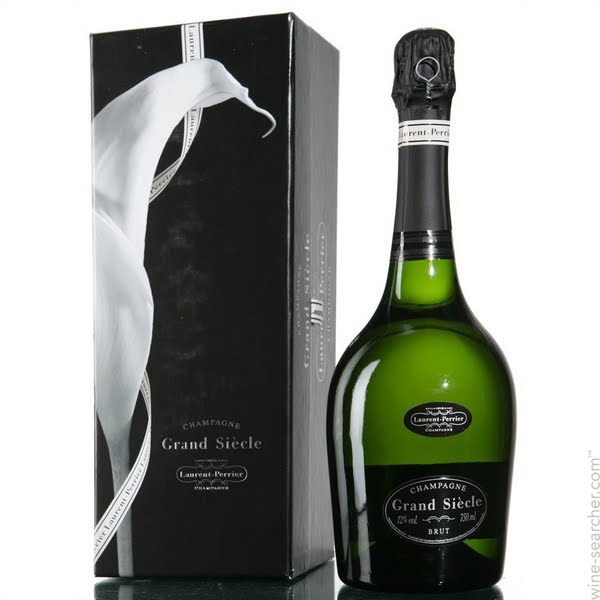 always been a
lover of Heidsieck’s Champagnes, and this one lived up
to every expectation I could have had. Toasty
multigrain bread notes found their counterpart in the
flavor of apricot preserves, and the subtly salty
finish lingered like a particularly beautiful memory
for some time.
always been a
lover of Heidsieck’s Champagnes, and this one lived up
to every expectation I could have had. Toasty
multigrain bread notes found their counterpart in the
flavor of apricot preserves, and the subtly salty
finish lingered like a particularly beautiful memory
for some time.
There was also a
handful of top-quality non-vintage Champagnes as well.
The Krug Grand
Cuvée ($170), as expected, was among
the highlights, a thoroughly complete wine with ample
fruit and berry, as well as more exotic notes of
lemongrass, preserved lemon, and nervy mineral
brightening the whole enterprise up with real finesse.
Laurent-Perrier’s
Grand Siècle ($110-$120) was a
shimmeringly transparent expression, the lime and
lemongrass of the mid-palate finishing on an almost
dry note that begged for food. And A.R. Lenoble’s Blanc de
Blancs Grand Cru ($50-$65) also hinted at the
exotic, with bright kaffir lime and mineral notes
balanced by aromas of white berries and pear.
By the end of the day,
it was abundantly clear that this wasn’t just an
exercise in decadence and pleasure, but a deeply illuminating educational experience.
The opportunity to assess, across such a wide range of
wines, what is happening at the topmost echelon of the
Champagne world was exceptionally edifying. Overall,
my takeaway from this was twofold. First, if you can
afford to spend the money on prestige cuvées,
it is worth doing so; the longevity and expressiveness
of these wines are just stunning. Second, the
experience highlighted yet again how important it is
to not just sip these Champagnes on their own but to
pair them with food; because, despite their prestige
and expense, they are incredibly versatile at the
table.
This time of year,
then, maybe we all should vow not just to drink more
Champagne, but to do so with family and friends and to
enjoy it alongside the holiday meals that define the
season as much as mistletoe and menorahs. If you pair
wisely, not only will both the food and the Champagne
benefit, but it will make the long slog between New
Year’s and springtime that much easier, and that much
more enjoyable. Which is why we drink Champagne in the
first place: Because it makes life better when we do.
PS: A sumptuous
and comprehensive new book, A Scent of Champagne by Richard
Julhin (Skyhorse Publishing, $47 ), is a superb new
entry on a much-discussed subject. Juhlin presents his
vast knowledge and well-respected opinions on France's
bubbly gift to man with erudition and stylish writing,
including 8,000 Champagnes tasted and rated since
1998. Highly recommended for the connoisseur.--John
Mariani
❖❖❖
AND WHILE
THEY'RE AT IT, LET THE LITTLE BRATS
CLEAN OUT
THE GREASE TRAPS!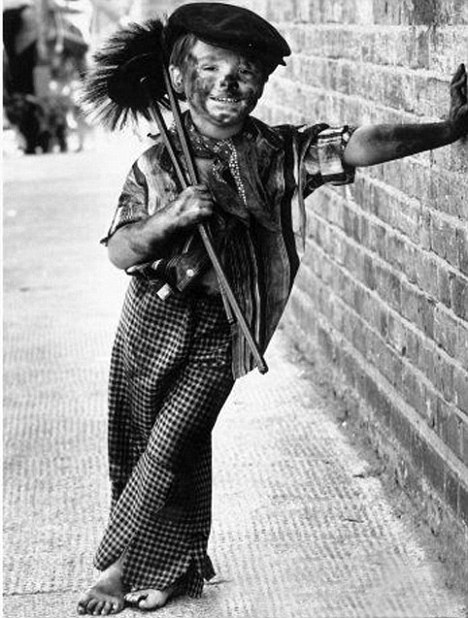
Republican Congressman Scott Kingston of Georgia,
speaking of funding the federal school-lunch program,
said, "Why don't you have the kids pay a dime,
pay a nickel to instill in them that there is, in
fact, no such thing as a free lunch? Or maybe sweep
the floor of the cafeteria."
 RUN THAT BY US AGAIN?
RUN THAT BY US AGAIN?
"Today, Brooklyn and Berkeley seem connected by an
underground tunnel in which hybrid vehicles carry
curing salts, butchery manuals and biodynamic wines
back and forth below the continent. But at the time,
nobody thought that West Coast sunshine was going to
rescue the borough of brownstones and strollers from
Manhattan’s long shadow."----Pete Wells, "Marco," NY Times (Dec.
18, 2013).
Any of John Mariani's
books below may be ordered from amazon.com.
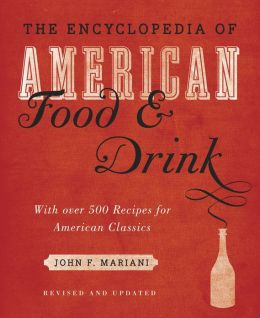 |
The Encyclopedia of American Food
and Drink by John F. Mariani
(Bloomsbury USA, $35) Modesty forbids me to praise my own new book, but let me proudly say that it is an extensive revision of the 4th edition that appeared more than a decade ago, before locavores, molecular cuisine, modernist cuisine, the Food Network and so much more, now included. Word origins have been completely updated, as have per capita consumption and production stats. Most important, for the first time since publication in the 1980s, the book includes more than 100 biographies of Americans who have changed the way we cook, eat and drink -- from Fannie Farmer and Julia Child to Robert Mondavi and Thomas Keller. "This book is amazing! It has entries for everything from “abalone” to “zwieback,” plus more than 500 recipes for classic American dishes and drinks."--Devra First, The Boston Globe. "Much needed in any kitchen library."--Bon Appetit. |
"Eating Italian will never be the same after reading John Mariani's entertaining and savory gastronomical history of the cuisine of Italy and how it won over appetites worldwide. . . . This book is such a tasteful narrative that it will literally make you hungry for Italian food and arouse your appetite for gastronomical history."--Don Oldenburg, USA Today. "Italian
restaurants--some good, some glitzy--far
outnumber their French rivals. Many of
these establishments are zestfully described
in How Italian Food Conquered the World, an
entertaining and fact-filled chronicle by
food-and-wine correspondent John F.
Mariani."--Aram Bakshian Jr., Wall Street
Journal.
"Equal parts
history, sociology, gastronomy, and just
plain fun, How Italian Food Conquered the
World tells the captivating and delicious
story of the (let's face it) everybody's
favorite cuisine with clarity, verve and
more than one surprise."--Colman Andrews,
editorial director of The Daily
Meal.com. "A fantastic and fascinating
read, covering everything from the influence
of Venice's spice trade to the impact of
Italian immigrants in America and the
evolution of alta cucina. This book will
serve as a terrific resource to anyone
interested in the real story of Italian
food."--Mary Ann Esposito, host of PBS-TV's
Ciao
Italia. "John Mariani has written the
definitive history of how Italians won their
way into our hearts, minds, and
stomachs. It's a story of pleasure over
pomp and taste over technique."--Danny Meyer,
owner of NYC restaurants Union Square Cafe,
Gotham Bar & Grill, The Modern, and
Maialino.
|
 |
 |
 |
 |
 |
 |
 |
 |
 Everett Potter's Travel Report:
Everett Potter's Travel Report: 
 Eating Las Vegas
is the new on-line site for Virtual Gourmet
contributor John A. Curtas., who since 1995
has been commenting on the Las Vegas food
scene and reviewing restaurants for Nevada
Public Radio. He is also the
restaurant critic for KLAS TV, Channel 8 in
Las Vegas, and his past reviews can be
accessed at KNPR.org.
Click on the logo below to go directly to
his site.
Eating Las Vegas
is the new on-line site for Virtual Gourmet
contributor John A. Curtas., who since 1995
has been commenting on the Las Vegas food
scene and reviewing restaurants for Nevada
Public Radio. He is also the
restaurant critic for KLAS TV, Channel 8 in
Las Vegas, and his past reviews can be
accessed at KNPR.org.
Click on the logo below to go directly to
his site.

Tennis Resorts Online: A Critical Guide to the World's Best Tennis Resorts and Tennis Camps, published by ROGER COX, who has spent more than two decades writing about tennis travel, including a 17-year stretch for Tennis magazine. He has also written for Arthur Frommer's Budget Travel, New York Magazine, Travel & Leisure, Esquire, Money, USTA Magazine, Men's Journal, and The Robb Report. He has authored two books-The World's Best Tennis Vacations (Stephen Greene Press/Viking Penguin, 1990) and The Best Places to Stay in the Rockies (Houghton Mifflin, 1992 & 1994), and the Melbourne (Australia) chapter to the Wall Street Journal Business Guide to Cities of the Pacific Rim (Fodor's Travel Guides, 1991).


MARIANI'S VIRTUAL GOURMET
NEWSLETTER is published weekly. Editor/Publisher: John
Mariani.
Contributing Writers: Christopher Mariani, Robert Mariani,
John A. Curtas, Edward Brivio, Mort Hochstein,
Suzanne Wright, and Brian Freedman. Contributing
Photographers: Galina Stepanoff-Dargery,
Bobby Pirillo. Technical Advisor: Gerry McLoughlin.
© copyright John Mariani 2014
